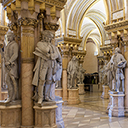0261 Forschungsstand und Forschungsfragen – Historische und aktuelle Positionen zur Skulptur am Ende der Habsburgermonarchie
Identifiers (Article)
Abstract
This article provides an overview of the history of research on monument sculpture in the former Habsburg Monarchy during the long 19th century. The focus is, on the one hand, on the sculptors, their origins, their educational paths, and areas of activity during the years of political upheaval from a centrally governed multinational state to the independent nations of Central Europe. On the other hand, it is on how art and cultural historians dealt with this complex situation. The contemporary representatives in the field, such as Eitelberger, Hevesi, and Ilg came from the greater area of the Danube Monarchy and therefore had an eye on these sculpture networks, while after 1918 the topic of monument sculpture took a back seat, and in recent decades was only worked on regionally (e.g. Renate Wagner-Rieger, ed., Die Wiener Ringstraße. Bild einer Epoche, 11 vols., Vienna 1969–1981). Cross-national research cooperation, however, between academics studying culture in Central Europe came to a standstill, due to language barriers and the partial division of Europe by the Iron Curtain. The article reports on the initiative of a university research group to restore these contacts and create a contemporary form of information networking.
Statistics


License

This work is licensed under a Creative Commons Attribution-NonCommercial-NoDerivatives 4.0 International License.



